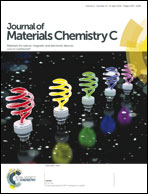Highly efficient blue and deep-blue emitting zwitterionic iridium(iii) complexes: synthesis, photophysics and electroluminescence†
Abstract
We report on a series of blue and deep-blue emitting zwitterionic iridium(III) complexes, consisting formally of a cationic Ir centre and a N,N′-heteroaromatic (N^N) ligand bearing negatively charged side groups, i.e. sulfonate and borate. The synthesis, photophysical and electrochemical properties of this series are described in detail together with their X-ray crystal structure determination. The reported complexes exhibit intense blue (λmax at 450 nm) and deep blue (λmax at 435 nm) emission in deaerated solution, similar to the related cationic complexes. The strategy employed, namely the internal salt formation, allows high solubility in many organic solvents as well as for some of the complexes a low sublimation temperature. For this reason, one of the complexes was further tested as an emitter in phosphorescent organic light emitting diodes (PhOLEDs). Despite the zwitterionic nature of the triplet emitter employed, the devices were fabricated by means of sublimation process. The devices showed a peak external quantum efficiency (EQE) as high as 11.0% and Commission Internationale d'Énclairage (CIE) coordinates x = 0.21 and y = 0.33.


 Please wait while we load your content...
Please wait while we load your content...